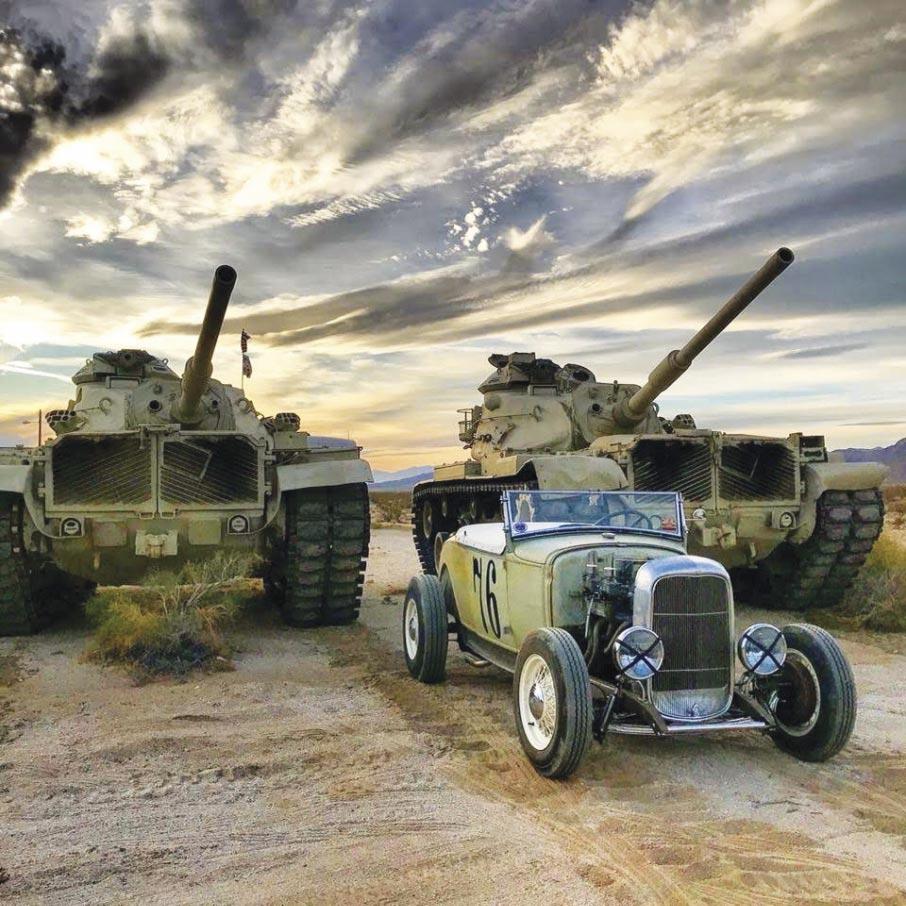
11 minute read
GreatGarages- The General Patton Memorial Museum
Two M-60 tanks and a 1930 Ford Roadster hot rod
photo Victor Garcia
GreatGarages
The General Patton Memorial Museum Reminds us this November 11 that Veterans Day is Every Day
written by David M. Brown
A Sherman tank, 'Rosie', is delivered to the Patton Museum, with Margit Chiriaco Rusche taking delivery
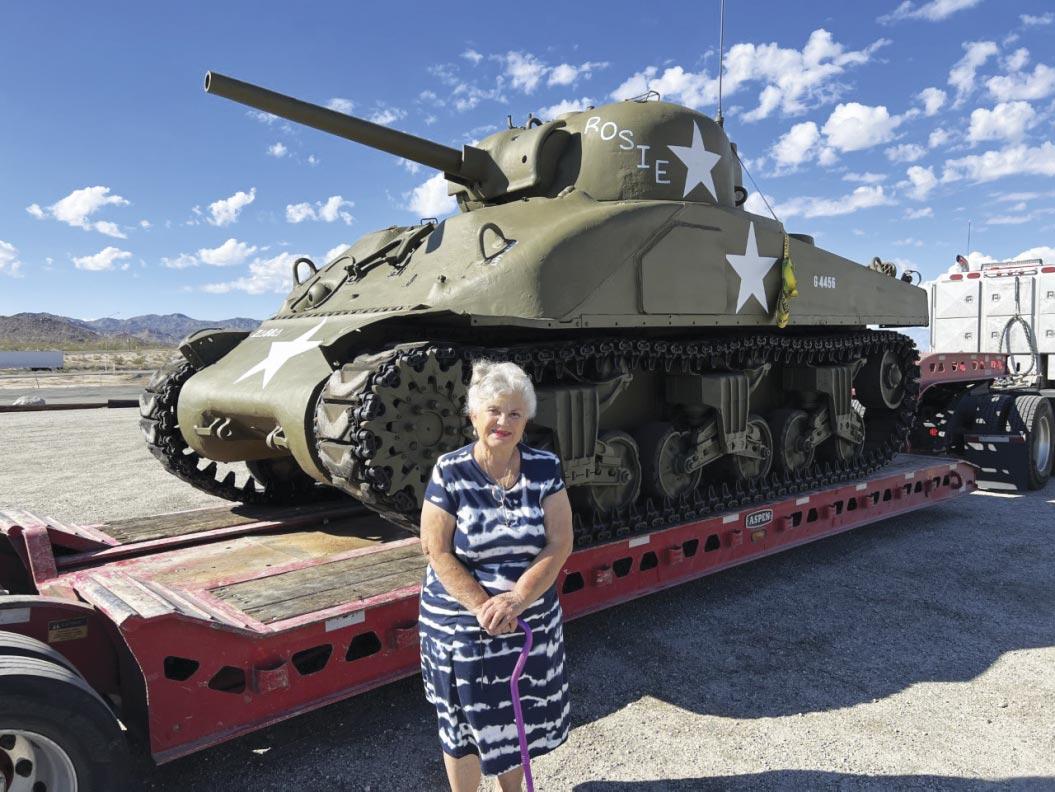
photo David Buehn
‘The highest privilege of citizenship is that of bearing arms for one’s country.’ -General George S. Patton Jr.
Next time you’re on I-10 east or west near Indio, California, watch for those light-brown road signs noting a point of tourist interest ahead. One is for the General Patton Memorial Museum; if you have the time, stop off at exit 173, Chiriaco Summit, once part of the Desert Training Center in World War II. Eight decades ago what happened here helped in the battle to save freedom and democracy.
About 28 miles east of Coachella and Indio, you can fill up on gasoline, snacks, pop and history at the exit area, anchored by the 501-C-3 nonprofit museum, which celebrates the achievements of the great general and his men. Here you can see more than 50 vehicles as well as artifacts, weapons, letters and other material from World War II, the Korean War, Viet Nam and later.
Every November 11, we remember the sacrifices our veterans have made throughout U.S. history. The most recent numbers document a population of 19,162,515, about 10.7% female, according to the Department of Veterans Affairs. Living World War II veterans total 240,329; 234 are dying each day. The Patton Museum celebrates all of them year round.
Dec. 7, 1941, seismically shook the country. Americans were tired of foreign wars and just beginning to thrive again after the Great Depression, but it was clear that all departments of the military had to reinvigorate quickly, and Americans with that. To meet the land challenge — in particular, that posed by the formidable German General Rommel and his panzer divisions — General George S. Patton (1885–1945) was charged with establishing the Desert Training Center in late 1941, just weeks after the Day of Infamy at Pearl Harbor.
Since World War I, when tanks first saw combat, Patton had advocated for armored strength teamed with knockout offensive action. At the DTC, his mission was to train a million men to do this in heat similar to that in the Sahara of North Africa, where the first American war action would occur. The chosen area was 18,000 square miles of Mojave and Colorado Desert in California and Arizona, which was Sahara-scorching in the summer months. Areas of Nevada were also included because of the similar climate.
M60 tank
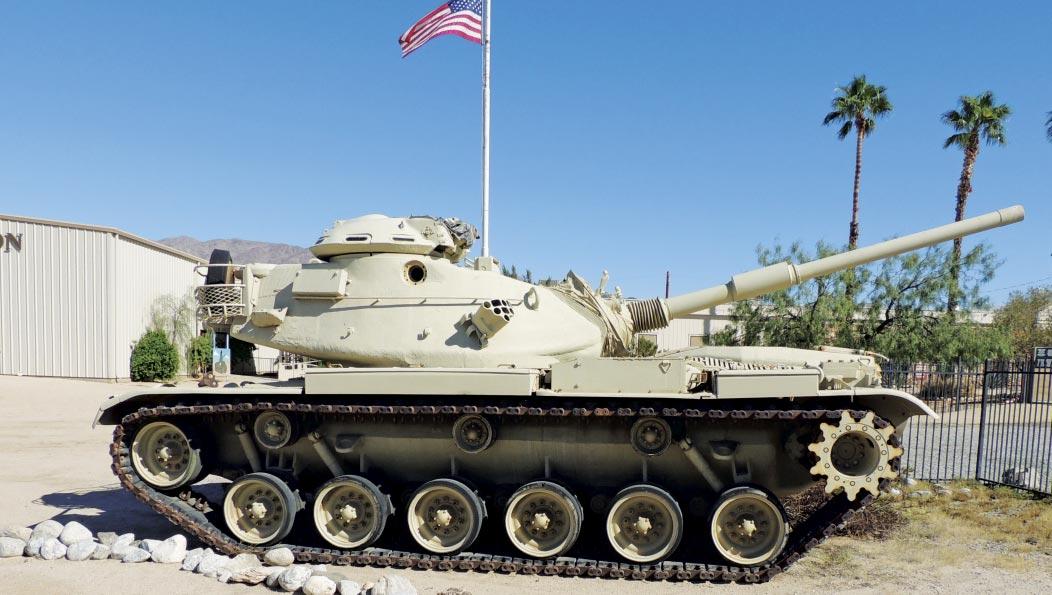
photo Peter Minix

1939 Cadillac is similar to the car Patton was riding in when it collided with a truck on an Army base

photo Jim Schieffer 2 ½-ton truck, 6x6, Amphibian
photo Jim Schieffer
The site, Chiriaco Summit, in the Coachella Valley, Riverside County, is also known as the California/Arizona Maneuver Area (CAMA). About 50 miles southeast of Palm Springs, it’s close to today’s Joshua Tree National Park. A world-famous concert is held in Coachella every year; few concert-goers and musicians are aware that their enjoyment is possible because of what was performed here eight decades before.
General Patton, Meet Joe & Ruth Chiriaco
In 1942, “Blood and Guts” Patton, as he was already called by his men, visited Joe and Ruth Chiriaco; he was an entrepreneur from Alabama and she a Minnesota native who came West to become a nurse. After purchasing the land where today’s museum is, the couple opened a general store and service station in 1933, next to the new US Route 60, now I-10. Soon the facility was attracting soldiers, local clientele and others traveling on the new highway. Early visitors were also the first rangers at Joshua Tree National Monument, now a National Park. General Patton needed Joe to help understand the desert terrain; he had been a surveyor on the transformative Colorado River Aqueduct in the mid-1930s. His daughter, Margit F. Chiriaco Rusche, who owns the property, says that Patton told her father: “You run the store, and I’ll run the war.”
The Army purchased 40-plus acres from the Chiriacos, while he established his headquarters, Camp Young, about a quarter mile from the store. Training continued at DTC until 1944, when the Allies declared victory in North Africa.
An airport used by Patton was built to the east of today’s museum. Today Chiriaco Summit Airport, owned by Riverside County, hosts private planes which stop at the café for lunch and serves search and rescue teams. “We’re well known for the General Patton Burger,” Margit says.
The collection and eventual museum started slowly. “My dad had saved a few items from the time when there were so

A 1944 amphibious truck
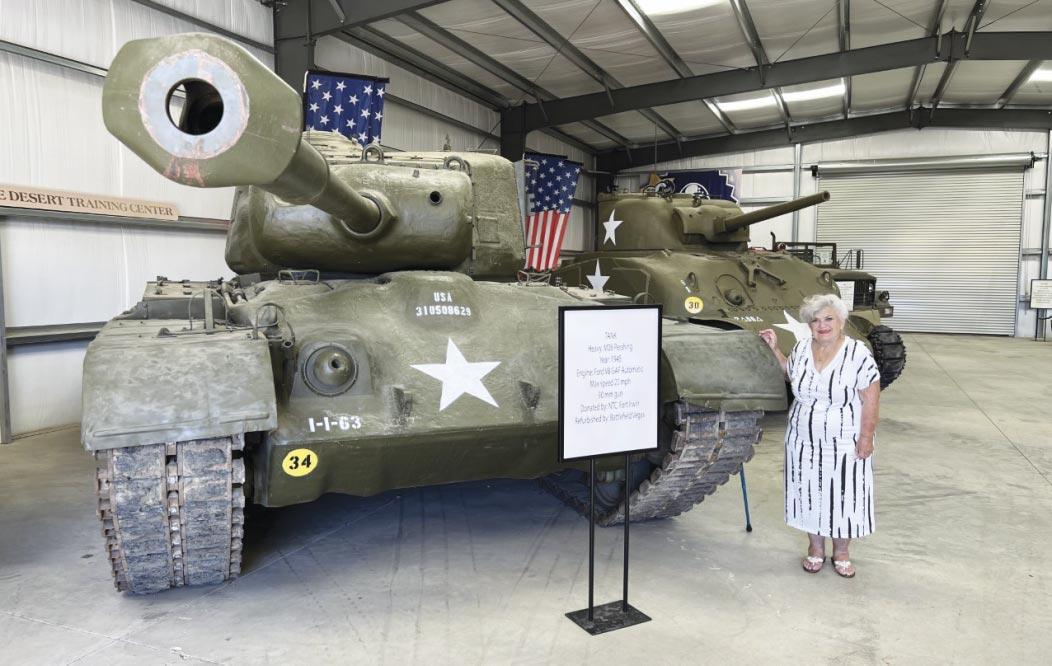
photo Jim Schieffer

Fire truck
photo Jim Schieffer A Pershing tank is enjoyed by Margit Chiriaco Rusche
photo Victor Garcia
many soldiers surrounding Chiriaco Summit from Camp Young and other camps,” she says.
“Dad saved three of the iron pipe frames used over jeeps in the beginning when they could not get the real tanks here fast enough for them to begin their maneuvers,” she adds. “After the camps were closed, others collected items, and many kept them at home until later when we received them as donations.”
In 1945, the Chiriacos established a memorial to Patton after he died on an Army base in Germany when a truck and the 1939 Cadillac accident he was a passenger in collided.
In 1985, the BLM placed a monument on the site of today’s museum. “There was immediate interest in providing a hub for the items and their interpretation,” Margit explains. The effort to build the museum began when she and Leslie Cone, representing BLM, formed a committee and established a 501-C-3. Her parents gifted the land for the museum in 1987. They died nine years later.
As a result of the efforts of the Bureau of Land Management and the private sector, the museum opened to a crowd of more than 5,000 on Veterans Day, November 11, 1988.
Among the 54 vehicles in the collection today are a variety of tanks, including a Pershing, a Sherman (“Rosie”), two M Stuarts and a number of M60s. Also in the collection are a dump truck,
M60A heavy tank in desert livery
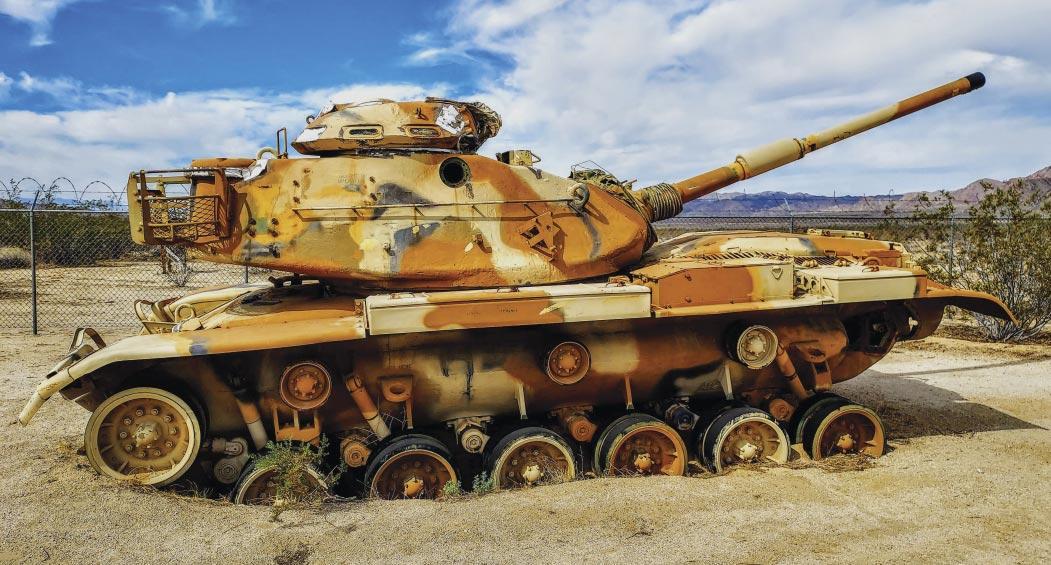
photo Jim Schieffer
jeeps, a trailer, an amphibious truck (a “duck”), an ambulance and a fire truck. The museum acquired many of the M60s by donation from Defense Reutilization Management Office and other government surplus agencies.
And, the museum includes weaponry and medals and other articles of interest that were part of DTC life, North African conflicts, European conflicts and the Pacific. Regular exhibits are held inside and out. An electric cars charging station, an antique store, book store and travel information center are also on the museum site.
Several acres showcase military vehicles in the Ed Hastey Park, all with interpretive signage. Also outside you can find several walls memorializing veterans and first responders. Visible from the interstate is a bronze statue of Patton by Viet Nam War vet Austin Deuel, erected in 1993. A member of the Scottsdale American Legion/VFW, he died in 2021.
The Metropolitan Water District donated a large map for the opening; it shows the 11 training camps used by the DTC. “Without the availability of water for the remote camps, we could not have gone into North Africa and then Europe and helped win the war in Europe, bringing peace to the world,” she says.
A large expansion of the museum occurred in 2017. Recently added is the 6,000-square-foot West Wing, made possible by N. Chandi and Suzanna Chandi; the Coeta and Donald E Barker Foundation is filling it with the interpretative educational exhibits. feet of tanks and large military vehicles for display and interpretation. Also new is the Camp Young USO Theater which shows several informative videos about the camps and the museum and the efforts of stars such as Al Jolson and Bob Hope to entertain the troops throughout the world.
“The most important significance of the museum is for the public to know what happened during the war and that training took place at Camp Young at Chiriaco Summit. The museum is laid out that anyone can do a ‘self tour’ and has a wealth of information displayed,” says Pete Minix, an Indio resident who has served on the board of directors and continues to donate work to the museum.
“Patton’s impact on Chiriaco Summit was tremendous. Overnight the little café went from about 20–25 people a day to 300. Joe and Ruth worked very hard to bring their little operation up to speed fast,” explains Mary Gordon, a writer who lives in Tucson. One of her books, Chiriaco Summit Built by Love to Last in the Desert, details the history of the area.
Tanks, Trucks & Jeeps
The oldest vehicle in the collection is the 1941 WC3 Dodge light-range utility truck, and the newest is a 1980 16-936 wrecker which was used in Operation Desert Storm.
The altar at The Patton Museum
photo Jim Schieffer
The bronze Patton statue is by Viet Nam vet Austin Deuel and erected in 1993. He died in 2021
photo Jim Schieffer
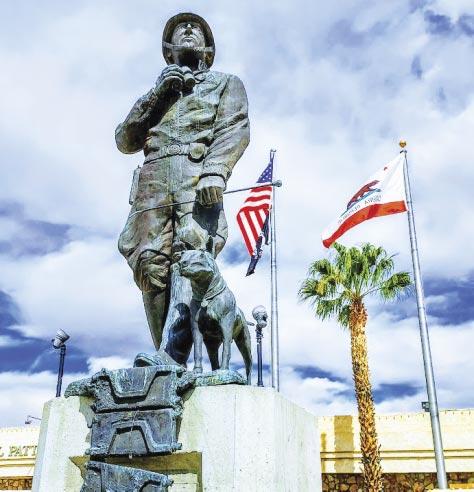
Here are some details on a half dozen of the other vehicles:
•Jeep, ¼ ton, 4x4, 1950–52 — Built by Willys-Overland, it has a 4-cylinder 54-horse engine and was the replacement for the WWII jeep, one of the vehicles, it’s said, that won the war. Changes include a 24-volt electrical, tailgate, gas filler outside the body and a different rear end. Total production was 62,329. This one was donated by John and Kathy Hendrix in memory of Joe E. Mann.
•2 ½-ton Truck, 6x6, Amphibian — Built in 1944, the DUKW “Duck” was manufactured by the General Motors Corporation with a 6-cylinder, 104-horsepower 270-ci engine. The truck was used during World War II and the Korean War by U.S. Armed Forces. The Leroy Allen Family donated it.
•M26 Pershing Tank — The heavy tank, built in 1945 by Ford, has a V-8 GAF automatic and can reach 20 mph. It carries a 90mm gun. Donated by NTC, Fort Irvin, it was refurbished by Battlefield Vegas.
•1939 Cadillac — This is similar to the one that Patton was riding in when it collided with a truck that killed him on an Army base in 1945.
•2-1/2-ton Cargo Truck— Built in 1943, it was used for communication and carrying telephone poles to installation points.
•Fire Truck — Manufactured by Dodge and the Waterous Company, this vehicle has a 6-cylinder Dodge 230-ci flathead producing 92 horsepower. It was used stateside by the U.S. Armed Forces. The Desert Centers Lions Club donated it to the museum.
On Veterans Day, The Patton Museum is celebrating Veterans Day with a memorial event, free to all visitors. The ceremony will honor Austin Deuel, the sculptor of the Patton statue at the entrance to the museum, and will welcome home the Sherman tank that has been refurbished by Battlefield Vegas; the company will be given the Founders Award. And, the museum will open the Colorado river Bailey bridge crossing the dry lagoon, gifted to the museum by the Bard Water District.
General Patton’s granddaughter, Helen Patton, says: “I consider my every visit to the General Patton Memorial Museum a privilege, not only because it touches me personally as a direct descendent but also as someone who through my constant study of the war has learned to appreciate the amount of preparation our soldiers’ efforts in Europe required. It’s riveting to stand at the place where young men, who would later give their all, were formed.” Her father, Patton’s son, was Brigadier General George Smith Patton IV (1923-2004).
She adds: “Here is a heritage all Americans can share, where freedom’s backbone begins for all nations and all people. Its representative is the unforgettable Patton! But only because soldiers in his wake took tactic and tenacity forward toward certain victory, which continues to inspire new generations of soldiers. May we never forsake nor belittle what this territory gave birth to. I will be eternally grateful to the founders of this museum and those who keep the history available and the ground sacred.”
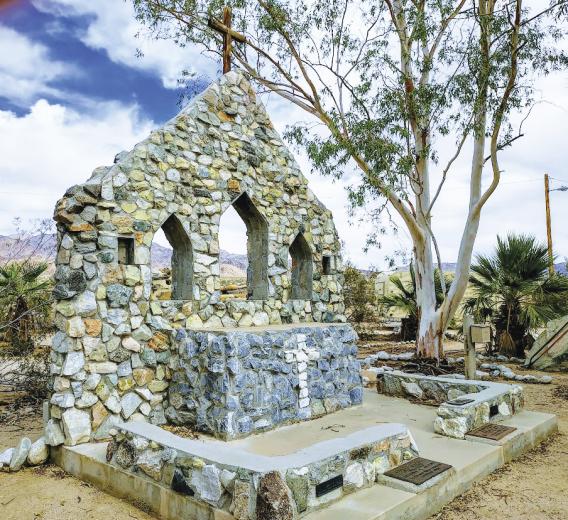
The museum is open daily, except Thanksgiving and Christmas, 9:30 a.m. to 4:30 p.m. An entrance fee is in place. For more information, see generalpattonmuseum.com and call 435.922.0213. If you or someone you know has a GreatGarage and would like it to be considered for an upcoming issue, please email us at info@highline-autos.com.










